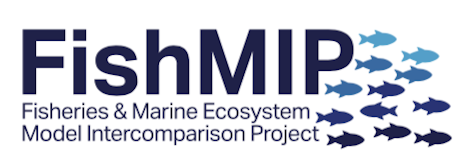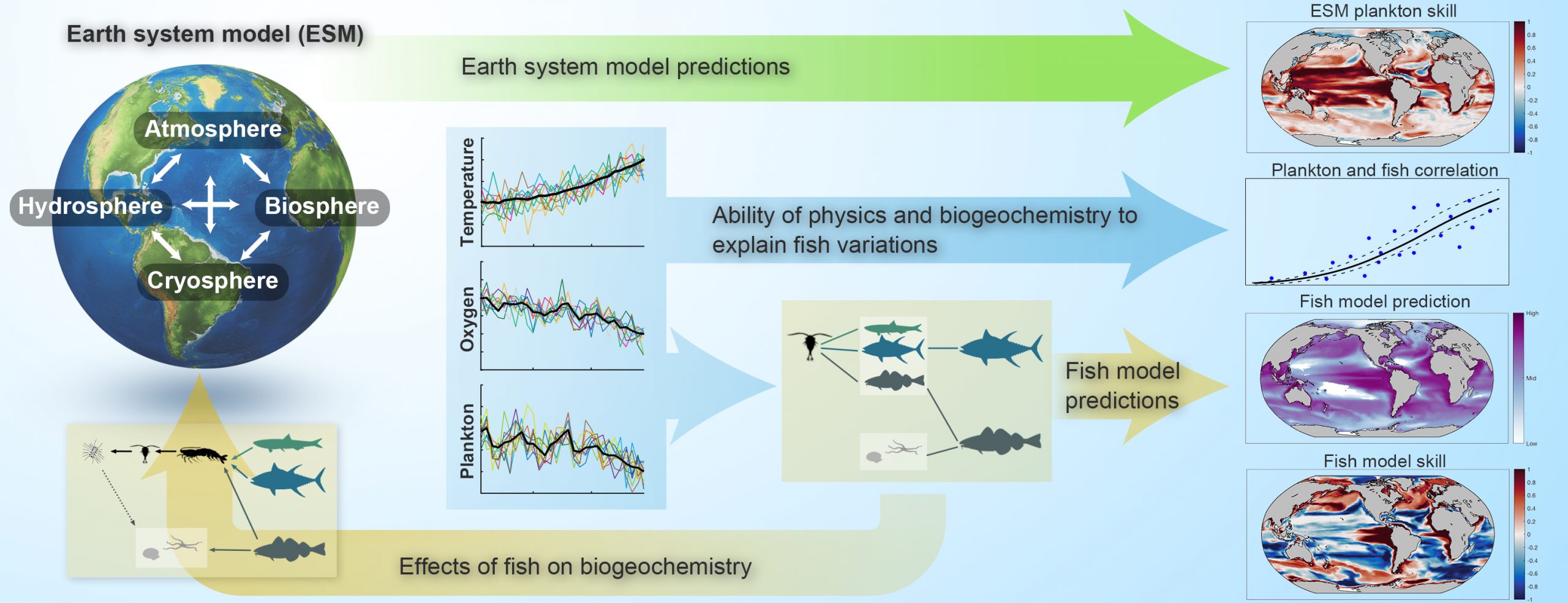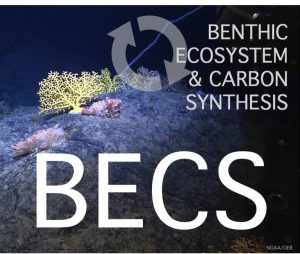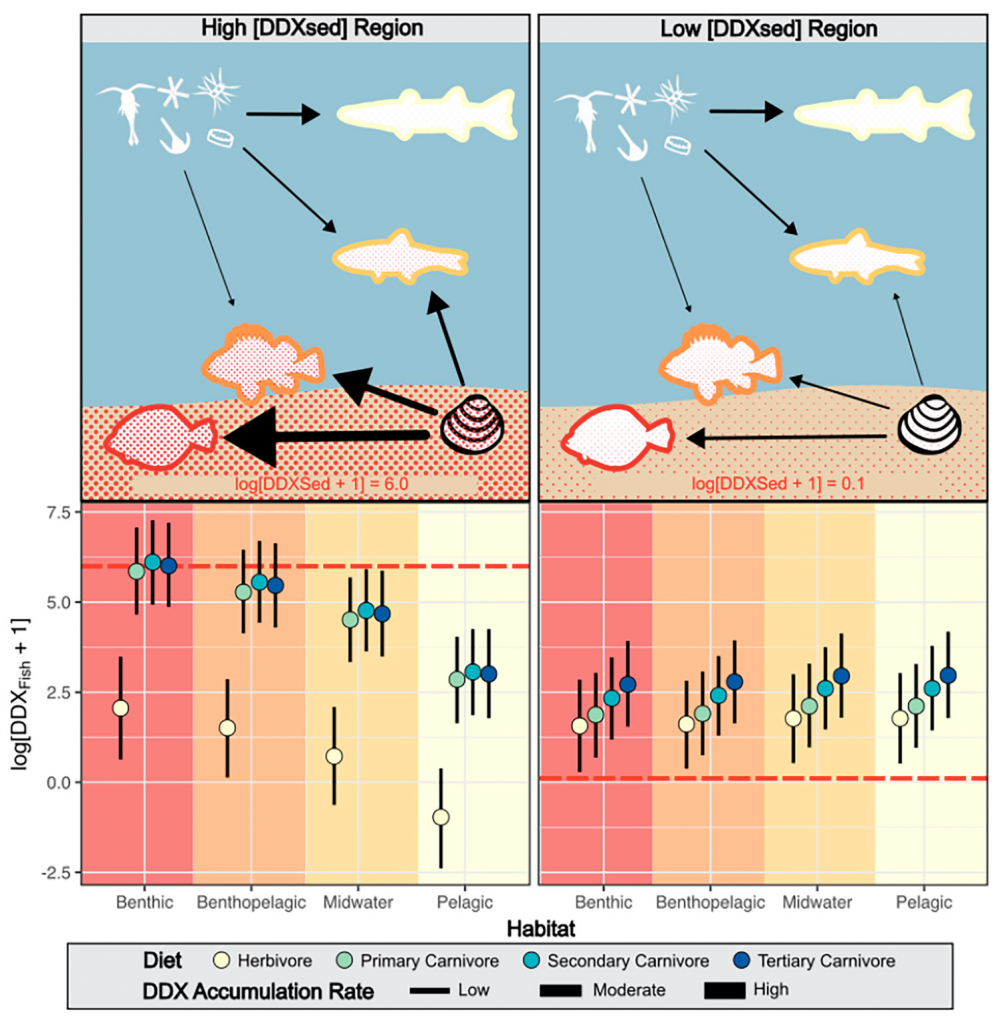
Graphic design by Jan D. Heuschele
FishErIes Size and functional TYpe (FEISTY) model
Dr. Petrik is one of the creators of the FEISTY model (Petrik et al. 2019) and the Petrik research group actively engages with this model to answer scientific questions and advance model development. FEISTY is a mechanistic size- and trait- based model of higher trophic level dynamics. FEISTY simulates three fish functional types (forage fish, large pelagic fish, and demersal fish) and an unstructured benthic invertebrate type. The biological rates in the model are based on allometry using the mass of each size class and are also temperature dependent. These processes include prey encounter, consumption, metabolism, growth, reproduction, and mortality. It represents basic life cycle dynamics, competitive and predatory interactions, and differences in life history, habitat, maximum size, and feeding preferences. The model provides global-scale understanding, quantification, and prediction of the ocean’s capacity for fish biomass and yield. To date, FEISTY has been used to examine the bottom-up mechanisms of fish biomass and yield (Petrik et al. 2019), the consequence of climate change on fish biomass and productivity (Petrik et al. 2020, Tittensor et al. 2021), the sensitivity of simulated fish biomass to individual and combined environmental drivers (Henneghan et al. 2021), how pelagic and benthic energy pathways structure fish food web biogeography through vertical habitat use (van Denderen et al. 2021), the contributions of fishes to the biological pump (Pinti et al. 2023), the biomagnification of mercury in marine food webs (Wu et al. 2023).

The Fisheries and Marine Ecosystem Model Intercomparison Project (Fish-MIP)
The goal of Fish-MIP is to bring together disparate marine ecosystem models to help better understand and project the long-term impacts of climate change on fisheries and marine ecosystems, and to use our findings to help inform policy. There are more than 40 international marine ecosystem modelers in the network. Fish-MIP has produced >15 publications. Petrik is one of the Earth-system model coordinators, one of co-coordinators of the global model simulations, and the main contact for the FEISTY model. Recent publications have been cited in the 6th Assessment Report from the UN’s Intergovernmental Panel on Climate Change (IPCC) on Climate Change 2022: Impacts, Adaptation and Vulnerability.
Benthic Ecosystem and Carbon Synthesis (BECS) Working Group
The BECS working group under the U.S. Ocean Carbon and Biogeochemistry (OCB) program strives to understand the carbon cycle and ecosystems within the land-to-ocean aquatic continuum by improving our understanding of related benthic processes and their representation in ocean and climate models. As one of the co-leads, Petrik is helping to organize webinars, workshops, and papers in an effort to bridge the knowledge gap between coastal observational and global modeling efforts. BECS brings together a community of observationalists and modelers to integrate knowledge on coastal and open ocean benthic fluxes and biota, and coastal water column nutrient fluxes, and benthic-pelagic interactions. Specifically, Petrik is lending her expertise on global biogeochemical models and the need of the marine ecosystem modeling community.

Mechanistically modeling the contributions of vertically migrating zooplankton and fishes to the ocean biological pump (NASA-OBB)
Marine zooplankton and fishes contribute to the ocean biological pump via passive transport of their metabolic byproducts and by active vertical migrations. The objective of this NASA EXPORTS2 project is to use a global coupled model of ocean physics, biogeochemistry, plankton, and fishes to simulate diel vertical migrations and track carbon. Our global modeling activities will enable a mechanistic understanding of ecosystem vertical structure and thus provide better estimates of organic matter fluxes via the biological pump. Specifically, our proposed work addresses how ecosystem structure and active vertical migrations regulate the export of organic matter, how they affect the transfer efficiency of this export, and the relative importance of active vertical migration in the transfer efficiency of organic matter to depth. We hope to identify relationships between remote sensing products and simulated ecosystem structure and export fluxes to improve current methods for estimating export production from satellite observations, or be used to create new algorithms that use remote sensing products to characterize migrant contributions to the biological pump.

A framework for testing the ability of Regional MOM6 to reproduce observed fisheries variability with diagnostics for model skill attribution (NOAA-CVP-MAPP)
This project aims to advance methodologies for the prediction of Large Marine Ecosystems by running simulations of two marine ecosystem models, BOATS and FEISTY, with hindcasts of Regional-MOM6 for the Northeast Pacific and Northwest Atlantic and compare them against fisheries-dependent and fisheries-independent observations of fish catch and biomass. Our research will improve the modeling and understanding of climate-related biophysical mechanisms that drive fisheries variability in US marine ecosystems. It will develop and deliver new diagnostics that will lay the foundation for process-level evaluation and benchmarking of Regional-MOM6 models. The addition of fish simulations and direct comparisons against fish and fisheries data will provide a powerful test for whether this regional modeling framework is “fit-to-task” for making seasonal-to-decadal predictions to inform management under NOAA’s Changing Ecosystem and Fisheries Initiative.

Global to Mesoscale Drivers of Oxygen Variability and Change in the Northeast Pacific (NOAA-CPO-CVP)
Identifying the role, mechanisms, and interactions between global to mesoscale drivers of O2 variability and change is critical for NOAA Changing Ecosystem and Fisheries Initiative’s mission to build reliable ecosystem predictions in key productive Large Marine Ecosystems of the Northeast Pacific (NEP). In this project, led by SIO researcher Yassir Eddebar, we will use model simulations and observational products to identify: i) the contribution and underlying mechanisms governing global, externally forced changes in O2 in the NEP, ii) how mesoscale processes influence the transient and mean O2 structure and variability in the NEP, and iii) how interactions across scales and ecosystem drivers modulate O2 variability and synergistic extremes across ecosystem stressors. We will synthesize our understanding of how these processes interact from global to regional scales to modulate the development of metabolic extreme events in the NEP. Petrik will specifically examine the biogeochemical and ecological consequences of such extreme events.

4-OCEANS: Human History of Marine Life: Extraction, Knowledge, Drivers and Consumption of Marine Resources, c.100 BCE to c.1860 CE (ERC Synergy)
4-OCEANS aims to assess the importance of marine life for human societies during the last two millennia. We contend that the harvest of marine resources played a critical, but as yet underappreciated and poorly understood, role in global history. To bridge this gap in our understanding, the four PIs will form an interdisciplinary team combining expertise in marine environmental history, climate history, natural history, geography, historical ecology and zooarchaeology. We will examine when and where marine exploitation was of significance to human society; how selected major socio-economic, cultural, and environmental forces variously constrained and enabled marine exploitation; and identify the consequences of marine resource exploitation for societal development. Through these objectives we will discover how marine resources as novel wealth altered societies throughout history. How might marine wealth have enabled some societies to escape food shortages? How did it trigger long-term socio-economic impacts and ecological consequences? How were marine resources valued, consumed, and energetically transformed? Revealing this history will open a new window on human-nature dynamics of profound importance for understanding developmental trajectories of human societies. 4-OCEANS will transcend the binary distinctions of East and West, global-north and global-south, indigenous and colonial, resource exploitation and wildlife conservation, nature and culture. In doing so, 4-OCEANS will uncover and chart historical trajectories towards sustainable and unsustainable food security and resource extraction, and identify their complex underlying drivers.
Zooplankton: the missing link in modeling the ocean carbon cycle (ARC)
What is arguably the biggest gap in our ability to close the ocean carbon cycle, and thus improve future forecasts of carbon sequestration and fisheries? The answer is our modeling of zooplankton, the most abundant animals on Earth. This project aims to build a next-generation ecosystem model that resolves zooplankton groups, their traits and key processes, generating novel insights into carbon sequestration and fisheries. Expected outcomes include new methods for zooplankton modeling, leading to a paradigm shift in how we model carbon cycling. This should provide significant benefits, including vastly improved estimates of carbon sequestration and fisheries production, vital for carbon budgets and food security in Australia and globally.

Incorporating fish in Earth system predictions (NOAA-CPO-MAPP)
Our objective is to extend ESM predictions to include fish explicitly by coupling an existing Fisheries Size and Functional Type model (FEISTY) to the MOM6 ocean general circulation model, thereby enabling direct simulation and prediction of potential fish catch, fish distributions, and food web structure. We will (1) evaluate and understand the dependencies and interactions between the higher trophic levels in FEISTY and the lower trophic levels represented in the underlying ocean biogeochemistry model, (2) tune and optimize solutions with empirical datasets, (3) produce an analysis of global ocean-sea-ice hindcast integrations of MOM6 with biogeochemistry and fish.
Towards the prediction of fisheries on seasonal to multi-annual time scales (NOAA-CPO-MAPP)
Our objective is to more deeply examine the variability, uncertainty, and source of predictability of physical and biogeochemical drivers, and the sensitivity of fisheries to them. Analyses will use an ensemble of seasonal-to-decadal prediction experiments to (1) estimate the amount of fisheries production variance explained by different drivers, (2) assess the skill in the predictability of the most important drivers of fish variability, (3) examine the spatiotemporal variability in the predictability of fisheries.
The predictability of oxygen and its metabolic consequences for fisheries on decadal time scales (NOAA-CPO-MAPP)
Temperature and oxygen availability jointly limit marine habitat viability, and can be explained with the Metabolic Index (MI), a physiologically mechanistic framework that explicitly combines the synergistic influence for a given organism. The objectives are to (1) assess the spatiotemporal skill and uncertainty of decadal predictions of environmental variables relevant to fish metabolic processes, (2) produce decadal predictions of the MI for representative taxa in each of the US Large Marine Ecosystems, (3) quantify how MI predictions will influence potential fisheries catches.
NOAA MAPP Marine Ecosystems Task Force (NOAA-CPO-MAPP)
The goal of all MAPP task forces is to create larger scale initiatives, communities of practice, leadership opportunities, organization around a topic, and value-added knowledge. The topic of the funded projects within this task force is “Modeling Climate Impacts on Predictability of Fisheries and Other Living Marine Resources.” The co-leads of this task force specifically aim to write at least two peer-reviewed journal articles, one a review of prediction in relation to fisheries and the other a synthesis paper of task force research, and also a white paper on how the task force has moved prediction science forward over this 3-year period.
Figure from McGill et al. 2024 PNAS
Tracking the entry and progression of San Pedro Basin barrel field pollutants through the California pelagic food web (Moore Foundation)
The recent rediscovery of a vast barrel field of DDT-laced sludge off the coast of southern California has captured the attention of the public, and raised concerns regarding impacts to economic, ecosystem and human health. Given that these barrels were dumped ~80 years ago, the mix of harmful compounds they contain have likely entered the ocean food web; however, the extent of toxin progression, impact and persistence remains unknown. Moreover, it is unclear if this barrel field continues to source toxins into the contemporary marine ecosystem. We propose to leverage SIO’s unparalleled biological collections from the California Current Ecosystem to reconstruct the scope and scale of toxin progression over the 70 years, and across the southern California coastal ocean. To do so, we will first use broad-spectrum mass spectrometry data to generate toxin “fingerprints” of the barrel field based on recently collected sediment samples. Subsequently, we will use these signatures as tracers, and through analysis of marine fish tissues sampled from SIO collections, will map the toxins across space and time. Finally, we will use these observations to develop and validate a novel bio-physical model of toxin transport in the marine environment that links physical ocean processes (advection and diffusion) with the biological processes of toxin transfer and biomagnification across trophic levels. Our efforts to quantify the penetration of toxins into marine food webs (or, importantly, lack thereof) will aid in efforts to restore and preserve the vitality of California’s marine resources. Furthermore, the uniquely detailed reconstruction of toxin progression in the ecosystem, and the associated process model of marine toxin fate and transport, will support a new generation of science aimed at understanding and mitigating biological impacts of anthropogenic emissions.


